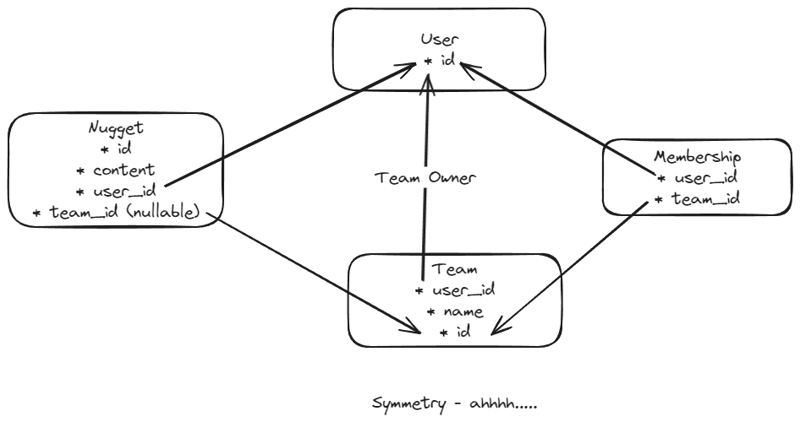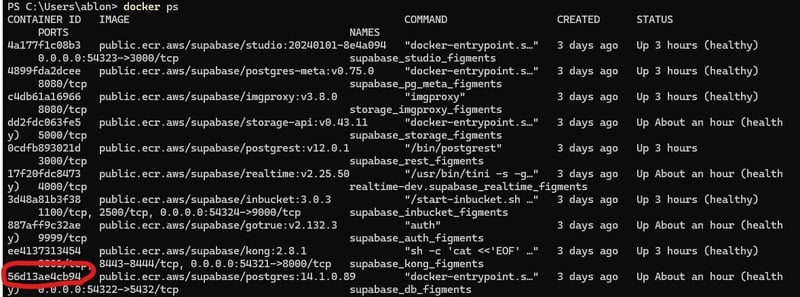Does Postgres' Row Level Security make developing apps easier, harder, or just more interesting?
I am working on a Supabase project that is going to have a data model that supports content (called nuggets) that can belong to either users individually or to teams.
Some of the features of this data model are:
- Users aren't required to have a team. They can setup an account and create as many nuggets as they want.
- If a user wants to share nuggets with other users they can:
- create a team
- assign nuggets to the team
- add other users to their team
- There is some room for flexibility in what access team members can have vs what the team owner has.
- If you want to go really crazy you can add a "role" field to the membership table for even more customization.
Most of this was really straightforward to setup with Supabase, but I did learn some things that I want to share
1) When using Supabase code that both creates and selects a record, make sure you've setup RLS rules for both:
I had code like this
const { data: newNugget, error: newNuggetError } = await supabase
.from('nuggets')
.insert({ user_id: userId, content: 'Gold' })
.select()
This code kept failing to create the record and it returned null for both data and error. It turns out I had setup a good rule for insert, but had forgotten select. Since there was no rule allowing select I kept getting back an empty result. I had no output to help me figure out what was wrong.
2) You can use functions in RLS rules but it gets complicated:
I wanted to have a postgres function called "is_team_member" that I could use in my RLS rules so that they were easy to read:
create schema private;
CREATE OR REPLACE FUNCTION private.is_team_member(q_team_id uuid)
RETURNS boolean
LANGUAGE plpgsql
-- security definer is used to prevent RLS recursion:
security definer
AS $function$
begin
return (EXISTS ( SELECT 1
FROM memberships
WHERE ((memberships.team_id = q_team_id) AND (memberships.user_id = auth.uid()))));
end;
$function$
;
create policy "Team members can select nuggets that belong to teams they are in"
on "public"."nuggets"
as permissive
for select
to authenticated
using (
private.is_team_member(team_id)
);
This code took several tries to land.
The first way I went wrong was I originally created my function in the public schema. By creating the function in public it became available for anyone to use. My first version also took both team_id and user_id as parameters so that anyone could've used it to leak data about who belonged to which team.
I also ran into recursion issues. is_team_member does a select on the memberships table which requires an RLS check via is_team_member, and so on...
I prevented recursion by adding "security definer" to the function. Read more about this here.
I kept the function out of the API by moving it to a private schema.
Any Supabase experts out there see anything else that could go wrong with this approach? I feel like I may have missed something else that could cause this to be insecure.
3) raise log to the rescue
Old-school console output based debugging is an underestimated skill. In creating the functions above I found that I could put statements like this into the function to gain some visibility into what was going on:
RAISE LOG 'The code got to here!';
To view these log messages for local development with Supabase you need to find the id of the docker container running postgres. Start with the "docker ps" command:
Use the output to pick out the id for the postgres container
Then use the "docker logs" command to see the container's output. In this example, the exact command I ran was "docker logs 56d13ae4cb94". "docker logs --follow 56d13ae4cb94" would have also worked as well and kept as stream of the output going.
4) Generate migrations
Supabase's ability to automatically generate migrations helped enormously in developing my RLS rules. I was able to use the local version of supabase studio to rapidly iterate and test my rules. Then once the RLS policies were ready I ran commands like the following to automatically create migrations for me:
yarn supabase db diff --schema private -f add_rls_helper_functions
yarn supabase db diff --schema public -f add_rls_policies_for_teams_memberships_nuggets
Summary
I really like the idea of the database itself performing access control for my app. This is a new paradigm for me and the learning curve is a little steeper than I had planned. However, Supabase helps a lot by providing an environment with RLS setup and ready to go.




















